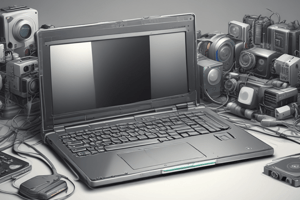Podcast
Questions and Answers
What is the primary function of the CPU in a laptop?
What is the primary function of the CPU in a laptop?
- To power the laptop when not connected to a power source
- To store data and applications
- To execute instructions and perform calculations (correct)
- To display images and text
What type of storage is known for its balance of capacity and speed?
What type of storage is known for its balance of capacity and speed?
- HDD
- Hybrid (correct)
- RAM
- SSD
Which type of laptop is designed for gaming?
Which type of laptop is designed for gaming?
- Chromebook
- Netbook
- Ultrabook
- Gaming Laptop (correct)
What is the primary function of RAM in a laptop?
What is the primary function of RAM in a laptop?
Which type of display uses organic compounds for display?
Which type of display uses organic compounds for display?
What is the primary function of a graphics card?
What is the primary function of a graphics card?
What is the primary function of a cooling system in a laptop?
What is the primary function of a cooling system in a laptop?
What is the primary function of a fingerprint reader in a laptop?
What is the primary function of a fingerprint reader in a laptop?
Flashcards are hidden until you start studying
Study Notes
Components
- CPU (Central Processing Unit): brain of the laptop, executes instructions and performs calculations
- RAM (Random Access Memory): temporary storage for data and applications, affects performance and multitasking
- Storage: holds operating system, programs, and data; types include:
- HDD (Hard Disk Drive): traditional spinning disk storage
- SSD (Solid State Drive): faster, flash-based storage
- Hybrid: combines HDD and SSD for balance of capacity and speed
- Display: screen showing images and text; types include:
- LCD (Liquid Crystal Display): traditional display technology
- LED: uses light-emitting diodes for backlighting
- OLED (Organic Light-Emitting Diode): uses organic compounds for display
- Graphics Card: handles graphics processing; types include:
- Integrated: shares system RAM for graphics processing
- Dedicated: has own memory and processing power
- Battery: powers laptop when not connected to a power source
Types of Laptops
- Netbook: small, lightweight, and budget-friendly; often limited processing power
- Ultrabook: thin, lightweight, and high-performance; often expensive
- Gaming Laptop: designed for gaming, with powerful processors, graphics cards, and cooling systems
- 2-in-1: convertible laptop with tablet functionality
- Chromebook: runs on Google's Chrome OS, designed for web-based applications
Features
- Operating System: software that manages laptop hardware and provides interface; popular options include:
- Windows
- macOS
- Chrome OS
- Linux
- Ports and Connectivity: options for connecting peripherals and accessories; common ports include:
- USB
- HDMI
- Ethernet
- Wi-Fi
- Bluetooth
- Cooling Systems: helps prevent overheating; types include:
- Fans
- Liquid Cooling
- Security Features: protects laptop and data; common features include:
- Fingerprint reader
- Facial recognition
- TPM (Trusted Platform Module)
- Encryption
Laptop Components
- CPU executes instructions and performs calculations, serving as the brain of the laptop
- RAM provides temporary storage for data and applications, affecting performance and multitasking
- Storage holds the operating system, programs, and data, with options including HDD, SSD, and Hybrid
- Display shows images and text, with types including LCD, LED, and OLED
- Graphics Card handles graphics processing, with options including Integrated and Dedicated types
- Battery powers the laptop when not connected to a power source
Laptop Types
- Netbook is a small, lightweight, and budget-friendly laptop, often with limited processing power
- Ultrabook is a thin, lightweight, and high-performance laptop, often expensive
- Gaming Laptop is designed for gaming, with powerful processors, graphics cards, and cooling systems
- 2-in-1 laptop is convertible with tablet functionality
- Chromebook runs on Google's Chrome OS, designed for web-based applications
Laptop Features
- Operating System manages laptop hardware and provides an interface, with popular options including Windows, macOS, Chrome OS, and Linux
- Ports and Connectivity allow for connecting peripherals and accessories, with common ports including USB, HDMI, Ethernet, Wi-Fi, and Bluetooth
- Cooling Systems prevent overheating, with options including Fans and Liquid Cooling
- Security Features protect the laptop and data, with common features including Fingerprint reader, Facial recognition, TPM, and Encryption
Studying That Suits You
Use AI to generate personalized quizzes and flashcards to suit your learning preferences.




